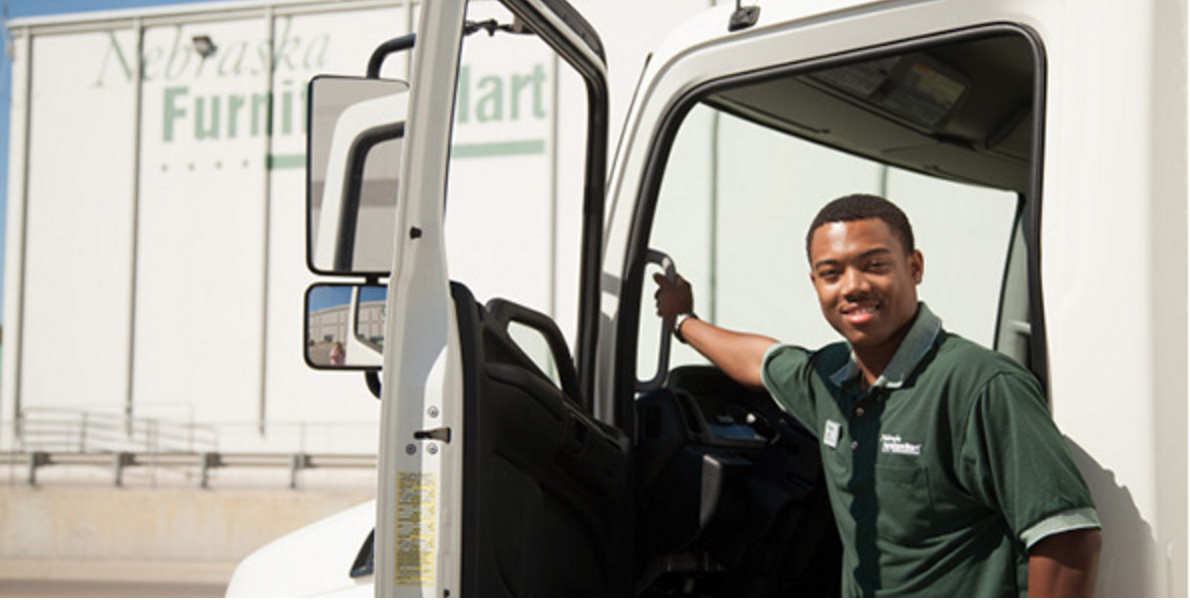Transportation companies of all types are feeling the impacts of e-commerce, whether or not their operations intersect directly with the hot business-to-consumer (B2C) market.
 Nebraska Furniture Mart uses the Appian Direct Route software from TMW to optimize its daily delivery routes.
Nebraska Furniture Mart uses the Appian Direct Route software from TMW to optimize its daily delivery routes.
Forrester, a leading research firm, projects that 17 percent of all U.S. retail sales will move online by 2022. This is a significant jump from the approximately 12.7 percent of retail sales that flowed through the channels of e-commerce in 2017.
One area of high impact from e-commerce is the expectations that customers have developed for a seamless delivery experience.
More than 64 percent of U.S. households are now Amazon Prime members and are accustomed to getting “free shipping” on orders with delivery of two days, and in some locations within two hours of online checkout.
Whether motor carriers work for Amazon or its competitors, the pressure is on to rethink and retool technology to meet these high expectations.
CCJ will be running a series of articles this month on how technology is adapting to new challenges and opportunities in this fast-growing market. We begin by looking at a few trends in fleet management software.
Shifting modes
Fleet management systems are supporting more relay operations in the truckload and less-than-truckload environment due to growth in e-commerce as well as enforcement of the electronic logging device (ELD) rule, says Jerry Robertson, chief technology officer of BOLT System.
 Jerry Robertson, chief technology officer of BOLT software.
Jerry Robertson, chief technology officer of BOLT software.
Robertson has seen customers of BOLT, an Internet-based fleet management and dispatch software system, increasing their use of relay operations using semi-trucks with double trailers.
Some carriers with ties to e-commerce are using 48-foot trailer combinations, he says. They dispatch a driver pulling double trailers to a drop yard near a city. A pair of domiciled drivers hookup to the trailers to make final-mile deliveries. The inbound driver then returns to a distribution center with two empty trailers.
Some truckload carriers are also adding cross-docking functionality to expand into the domain traditionally held by LTL carriers. It’s not uncommon for truckload carriers to offer multi-stop pickup and delivery routes through their terminal network, says Robert Brothers, manager of product development for McLeod Software.
To respond to this trend, McLeod Software has added a Final Mile module to its LoadMaster dispatch and fleet management system used by truckload carriers. The module handles the additional order requirements of LTL movements and cross-docking, he says.
The B2C formula
LTL carriers have seen the most impact from e-commerce and are using new technologies to improve their route planning and execution for B2C deliveries in residential areas.
 Ben Wiesen, vice president, products and services, Carrier Logistics Inc.
Ben Wiesen, vice president, products and services, Carrier Logistics Inc.
The cloud-based FACTS freight management system from Carrier Logistics Inc. (CLI) was born in the LTL world and has expanded in a number of ways to meet the requirements of last-mile logistics, says Ben Wiesen, CLI’s vice president of products and services.
Carriers that make B2C deliveries have to follow a standard formula to meet customer expectations, he says. First, they must offer delivery scheduling solutions and provide real-time, accurate visibility of ETA status, he says.
The FACTS system has a route planning and optimization component that fleets use to schedule deliveries and to calculate ETAs. The system calculates the driving time to the first stop on a route, and between all subsequent stops. The calculation uses standards for handling time by each type of delivery — business, residential, inside deliveries, curbside and more.
Fleets could share real-time ETA information with the end customer, but most do not as that “tends to lead to disappointment,” he says, since routes never progress exactly as planned. Instead, fleets will typically publish ETAs by padding the time window by an hour or so.
Another part of the formula for successful B2C deliveries is being able to re-route and redirect shipments on a short notice, Weisen says. A customer may ship the wrong product or place the wrong shipment label on the order.
Rerouting shipments is “not easy without technology,” he says. Fleets that use the CLI product can use a dock scanning application that alerts dock workers to “take care of those things,” he says.
Photographic evidence
To keep up with the fast-paced demands in this sector of the economy, final-mile transportation and logistics providers are looking for new mobile data capture solutions, says James Stevenson, vice president of sales for TMW Systems.
Final-mile deliveries require drivers to capture information outside the cab such as electronic signatures and various exceptions. Mobile data capture solutions are needed to create a more efficient and “clean” invoicing process, he explains.
Taking pictures of deliveries has become very important to help prevent cargo claims, Robertson says, as well as speed deliveries when exceptions do happen.
“You are trying to take the driver out of the process of negotiating a settlement on site,” Robertson says.
TMW Systems, BOLT and CLI all say they have developed their own mobile apps as well as partnered with third-party developers to integrate mobile technologies into their dispatch and routing systems for final-mile logistics.
Note: This article was written by Aaron Huff, senior editor of Commercial Carrier Journal, a partner publication of Hard Working Trucks.








